Key Takeaways
- Strategic Keyword Selection: Uncover the art of choosing keywords wisely, leveraging Semrush’s insights to target high-value, low-competition terms, and ensuring your content aligns with user intent.
- Holistic SEO Mastery: Semrush isn’t just a tool; it’s a compass guiding you through a holistic SEO journey. From granular keyword analytics to content integration and dynamic adaptation, master the nuances of SEO for enduring digital success.
- Data-Driven Agility: The true Semrush advantage lies in data-driven decision-making. Continuously monitor keyword performance, adapt strategies based on real-time insights, and navigate the evolving SEO landscape with agility and precision.
In the ever-evolving landscape of digital marketing, where the virtual highways of the internet are teeming with information, standing out amidst the digital noise requires a strategic approach.
In the realm of Search Engine Optimization (SEO), mastering the art of keyword research is akin to possessing a powerful compass that guides your online presence through the vast wilderness of search engine algorithms.
Also, read our top guide on how to become an SEO expert in just 5 easy steps.
Enter Semrush, a beacon of digital empowerment that illuminates the path to SEO success.
This comprehensive guide aims to unravel the intricacies of Semrush Keyword Research, empowering you with the knowledge and tools needed to not just navigate, but thrive in the competitive online ecosystem.
Picture this as your roadmap to unlocking the full potential of your digital presence, as we delve deep into the nuances of keyword research and how Semrush, a formidable all-in-one SEO toolkit, can serve as your trusted companion on this journey.
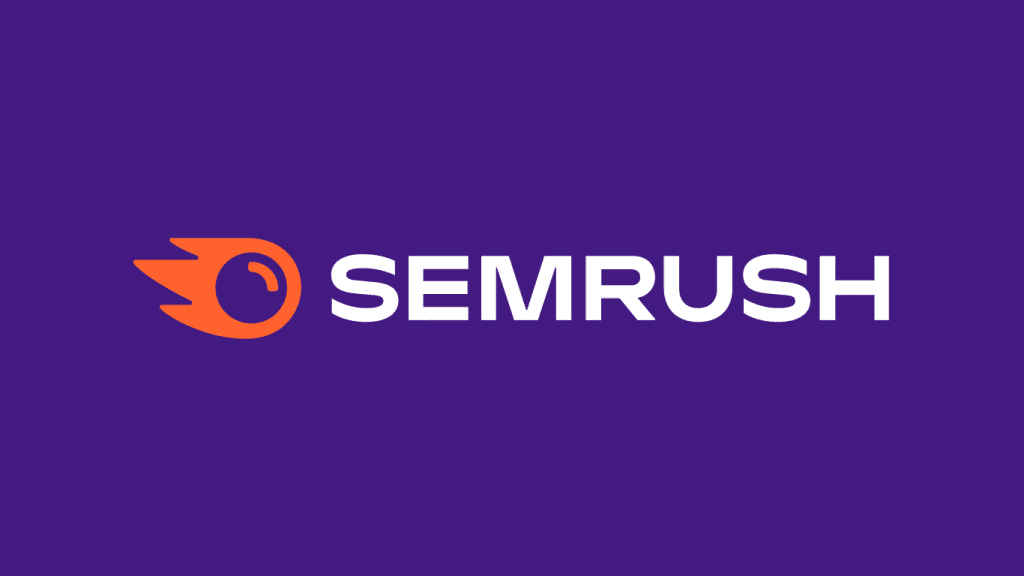
The SEO Symphony: Unveiling the Power of Keywords
Before we embark on this expedition through the corridors of Semrush’s keyword prowess, let’s take a moment to understand the symphony of SEO.
In the grand orchestration of search engine algorithms, keywords are the melodic notes that resonate with the virtual audience.
Every search query is a chord, and the way these keywords harmonize determines the success or obscurity of your digital composition.
The world of SEO is not merely about ranking on the first page of search engine results; it’s about orchestrating a seamless user experience.
Effective keyword research isn’t a one-size-fits-all endeavour; it’s about uncovering the keywords that resonate with your target audience, aligning your content with their needs, and ultimately, propelling your brand into the spotlight.
Semrush: Your Conductor in the SEO Symphony
As we venture into the heart of this guide, Semrush takes center stage.
Positioned as an industry-leading SEO toolkit, Semrush isn’t just a tool; it’s a virtuoso conductor, guiding your SEO efforts with precision and finesse.
It goes beyond mere keyword analysis, offering a comprehensive suite of features designed to elevate your digital strategy.
Whether you’re a seasoned SEO maestro or a novice navigating the intricate notes of online visibility, Semrush stands as a beacon of empowerment.
From dissecting keyword competition to uncovering untapped opportunities, Semrush equips you with a robust set of instruments to fine-tune your online performance.
Your Gateway to SEO Excellence: A Sneak Peek
In the chapters that follow, we’ll embark on a systematic exploration of Semrush Keyword Research, leaving no stone unturned.
From the foundational understanding of keywords and their pivotal role in SEO to the intricate features within the Semrush toolkit, this guide is your passport to SEO excellence.
Buckle up as we journey through creating a Semrush account, navigating the dashboard, deciphering keyword metrics, and unleashing advanced features that can give you a competitive edge.
By the end of this odyssey, you’ll not only be well-versed in the language of keywords but also armed with the practical insights needed to boost your SEO endeavors.
But, before we venture further, we like to share who we are and what we do.
About AppLabx
From developing a solid marketing plan to creating compelling content, optimizing for search engines, leveraging social media, and utilizing paid advertising, AppLabx offers a comprehensive suite of digital marketing services designed to drive growth and profitability for your business.
AppLabx is well known for helping companies and startups use SEO to drive web traffic to their websites and web apps.
At AppLabx, we understand that no two businesses are alike. That’s why we take a personalized approach to every project, working closely with our clients to understand their unique needs and goals, and developing customized strategies to help them achieve success.
If you need a digital consultation, then send in an inquiry here.
Semrush Keyword Research: A Complete Guide to Boost Your SEO
- Understanding Keyword Research
- Introduction to Semrush
- Getting Started with Semrush Keyword Research
- Using Semrush for Keyword Analysis
- Advanced Semrush Features for Keyword Research
- Implementing Semrush Keywords into Your Content Strategy
- Monitoring and Adjusting with Semrush
1. Understanding Keyword Research
In the sprawling landscape of digital marketing, the foundation of a robust SEO strategy rests upon the bedrock of effective keyword research.
Unraveling the intricacies of this critical aspect is akin to deciphering the language that search engines speak.
Let’s embark on a comprehensive journey to understand the pivotal role of keyword research and why it’s the cornerstone of online visibility.

Importance of Keywords in SEO: Unveiling the Significance
Keywords are the linchpin that connects user intent with search engine algorithms.
Consider this: 68% of online experiences begin with a search engine, emphasizing the paramount importance of keywords in directing organic traffic.
Each search query is a user expressing their intent, and keywords act as the translators that bridge this intent to relevant content.
Keyword Relevance and User Intent
Understanding the nuances of user intent and crafting content around relevant keywords is the bedrock of successful SEO.
A deep dive into user behaviour and preferences lays the groundwork for effective keyword selection.
Example: Consider a user searching for “best budget smartphones.”
In this scenario, the keywords “best,” “budget,” and “smartphones” are pivotal, reflecting the user’s intent to find affordable yet high-quality mobile devices.

How Search Engines Use Keywords: The Algorithmic Language
Search engines are sophisticated interpreters of the digital landscape, utilizing complex algorithms to decipher the meaning behind every search query.
Google’s RankBrain and Machine Learning
Understanding how search engines interpret keywords is paramount.
Google’s RankBrain, for instance, employs machine learning to comprehend user intent, making it crucial to align your content with both explicit and implicit queries.
Example: Google’s RankBrain, a machine-learning algorithm, interprets the meaning behind queries and adjusts search results accordingly.
If a user searches for “best running shoes,” RankBrain understands the intent goes beyond just information—it implies an interest in purchasing.

Role of Keyword Research in SEO Strategy: A Strategic Imperative
A well-crafted SEO strategy is a roadmap to online success, and at its core lies the strategic integration of targeted keywords.
Effective keyword research doesn’t just identify relevant terms; it illuminates the path to optimizing content, improving rankings, and ultimately driving organic traffic.
The Long-Tail Advantage
Long-tail keywords, often comprising three or more words, offer a strategic advantage.
They may have lower search volumes, but they are highly targeted, attracting users with specific needs.
Example: While “running shoes” might be a highly competitive keyword, targeting a long-tail variation like “best running shoes for flat feet” narrows the focus, reducing competition and attracting a more specific audience.
Content Relevance and User Experience
Striking a balance between keyword optimization and user-centric content is crucial. Search engines reward relevance, and user satisfaction is a key factor in determining rankings.
Example: Crafting content that seamlessly integrates keywords not only improves SEO but enhances user experience.
If a user searches for “how to tie a tie,” a well-optimized page providing step-by-step instructions satisfies both search engines and users.
The Evolving Landscape of Keyword Trends
The digital terrain is dynamic, and so are keyword trends.
Staying abreast of industry-specific keywords and adapting to evolving user behavior is integral to maintaining SEO efficacy.
Seasonal and Trending Keywords
Incorporating seasonal and trending keywords into your strategy capitalizes on timely opportunities, aligning your content with current user interests.
Example: Searches for “gift ideas” surge during the holiday season. Crafting content around seasonal keywords taps into trends, attracting a wave of relevant traffic.
Mobile-First Keywords and Voice Search
The prevalence of mobile devices and the growth of voice search reshape the keyword landscape. Optimizing for mobile-first and voice-centric queries is imperative for modern SEO.
Example: With the rise of voice search, the use of natural language in keywords becomes pivotal. Instead of typing “best Italian restaurants,” users might ask, “What are the best Italian restaurants near me?”
2. Introduction to Semrush
In the dynamic landscape of digital marketing, having a robust SEO toolkit is akin to wielding a master craftsman’s arsenal.
Semrush, a name synonymous with digital empowerment, stands as a multifaceted tool that transcends conventional boundaries.
This section serves as a gateway to the expansive world of Semrush, providing a comprehensive overview of its significance in the realm of SEO.
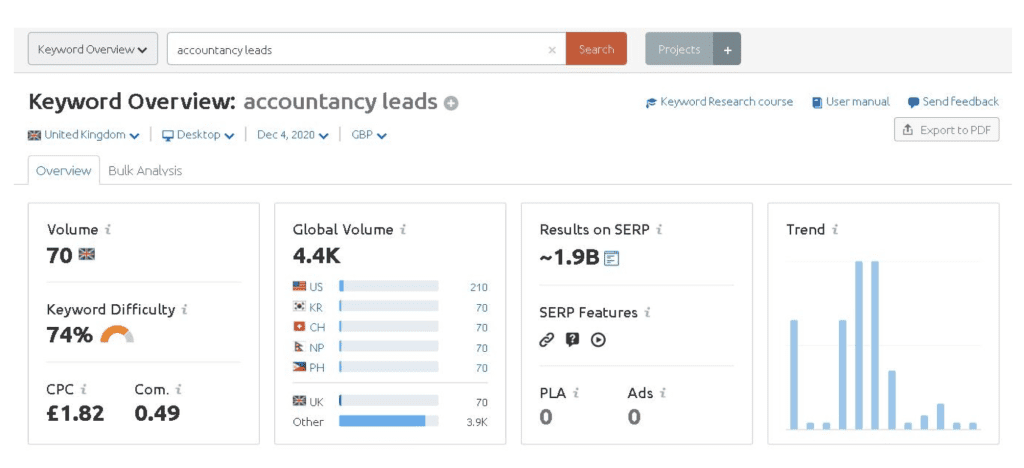
Overview of Semrush: Beyond Keywords to Comprehensive SEO
Semrush isn’t merely a tool; it’s a comprehensive suite of solutions designed to elevate your digital strategy.
Renowned as an all-in-one marketing toolkit, Semrush extends its reach beyond keyword analysis, offering a plethora of features to optimize every facet of your online presence.
Semrush’s Market Dominance
Semrush’s expansive user base attests to its market dominance.
Trusted by industry leaders and newcomers alike, it has emerged as a go-to solution for those seeking a comprehensive approach to digital marketing.
As of December 10, 2023, Semrush has 10 million users who already tried Semrush. Its widespread adoption is a testament to its effectiveness.
Key Features of Semrush: A Symphony of SEO Solutions
Semrush unfolds like a Swiss Army knife of digital marketing, offering an array of tools and features to dissect, analyze, and optimize every aspect of your online strategy. Let’s delve into some of the key features that make it an indispensable asset for SEO enthusiasts.
Keyword Analytics: Unraveling Search Intent
Keyword analytics form the cornerstone of Semrush, offering a granular understanding of search intent.
This tool empowers users to not only identify high-value keywords but also understand the semantic landscape surrounding their primary targets.
Semrush’s Keyword Overview tool provides in-depth insights into search volume, keyword difficulty, and related terms. For instance, if targeting “digital marketing,” it reveals variations like “online marketing” and “internet marketing,” allowing for a comprehensive approach.
Backlink Analysis: Gauging Authority and Trust
In the SEO realm, backlinks are akin to digital votes of confidence. Semrush’s Backlink Analysis feature enables users to dissect the link-building strategies of competitors and leverage this insight to enhance their own authority.
Semrush’s Backlink Analytics tool allows users to explore their backlink profile and that of competitors. Understanding the link-building strategies of top-ranking sites informs a strategic approach to building authoritative backlinks.
Site Audit: A Comprehensive Health Check
A website’s performance is integral to SEO success. Semrush’s Site Audit feature serves as a diagnostic tool, uncovering potential issues and providing actionable insights to bolster the overall health of a site.
Semrush’s Site Audit tool meticulously examines a website’s health, identifying issues like broken links, duplicate content, and page speed concerns. Resolving these issues not only improves SEO but also enhances user experience.
Benefits of Using Semrush: Empowering Your Digital Journey
The adoption of Semrush isn’t merely a choice; it’s a strategic decision to empower your digital journey. Let’s explore the tangible benefits that set Semrush apart as a catalyst for online success.
Improved Keyword Strategy and Targeting
Semrush’s ability to refine and optimize keyword strategies translates into tangible results. The data-driven approach ensures that your content resonates with your target audience, leading to improved organic traffic.
Competitive Advantage through In-Depth Analysis
Semrush’s competitive analysis features provide a strategic edge. By dissecting the strategies of competitors, businesses can identify gaps, capitalize on untapped opportunities, and position themselves as industry leaders.
Time and Resource Efficiency
Efficiency is the currency of modern digital marketing. Semrush’s automation capabilities not only expedite tasks but also free up valuable resources, allowing marketers to channel their efforts toward high-impact strategies.
3. Getting Started with Semrush Keyword Research
Embarking on the journey of Semrush keyword research is akin to unveiling a treasure trove of insights that can catapult your SEO strategy to new heights.
In this section, we’ll delve into the foundational steps of getting started with Semrush, exploring the essential aspects from account creation to project setup.

Creating a Semrush Account: Your Portal to Digital Mastery
Creating a Semrush account is the initial step toward unlocking a myriad of SEO tools and features.
This process is straightforward and serves as your gateway to a comprehensive suite of digital marketing resources.
Account Types and Subscription Plans
Understanding the range of subscription plans allows users to choose the one that aligns with their requirements.
The diversity of plans ensures that Semrush caters to the needs of freelancers, small businesses, and enterprise-level organizations.
Example: Semrush offers various subscription plans tailored to different user needs, including Pro, Guru, and Business plans.
Each plan unlocks specific features, ensuring scalability as your digital presence grows.

Free Trial Period and Onboarding Resources
The free trial period empowers users to familiarize themselves with Semrush’s capabilities.
Coupled with onboarding resources, this ensures a smooth transition into the SEMrush ecosystem.
Example: Semrush provides a free trial period, allowing users to explore the tool’s features before committing to a subscription. Additionally, comprehensive onboarding resources, including tutorials and webinars, ease the learning curve for new users.
Navigating the Semrush Dashboard: A Tour of Insights
Upon entering the Semrush dashboard, users are greeted with a wealth of information and tools. Familiarizing yourself with the layout and key features is essential for efficient navigation.
Overview of Semrush Dashboard Sections
Understanding the purpose of each dashboard section enables users to navigate seamlessly.
Domain Analytics, for instance, provides insights into a website’s performance, while Keyword Analytics delves into the specifics of keyword data.
Example: The Semrush dashboard is segmented into key sections, including Domain Analytics, Keyword Analytics, and Project Overview. Each section provides a specific lens through which users can analyze and optimize their digital strategy.

Customizing Dashboard Widgets and Reports
Tailoring the dashboard to showcase pertinent metrics streamlines the data visualization process.
Custom reports provide a snapshot of performance, facilitating data-driven decision-making.
Example: Semrush allows users to customize their dashboard by adding widgets that display specific metrics and data. Creating custom reports ensures that users focus on the key performance indicators (KPIs) most relevant to their goals.
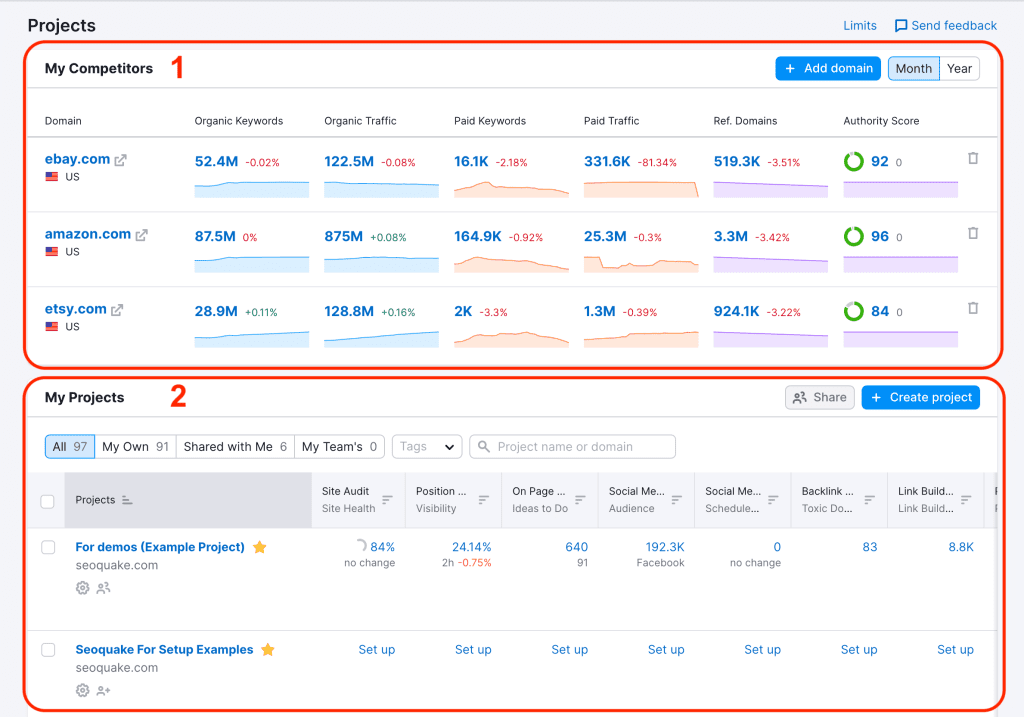
Setting Up Projects: A Strategic Approach to Keyword Tracking
Projects within Semrush are the linchpin of effective keyword tracking and analysis.
By setting up projects, users gain a holistic view of their digital landscape, enabling strategic decision-making.
Defining Project Objectives and Goals
Establishing project objectives aligns Semrush features with strategic goals.
Whether it’s enhancing visibility or outperforming competitors, Semrush projects become a roadmap for success.
Example: A project might have objectives such as improving organic traffic by 20% or increasing keyword rankings in a specific industry. Clearly defining goals allows for targeted keyword tracking and analysis.
Competitor Tracking and Analysis
Understanding how competitors fare in the digital arena is integral.
Semrush’s competitor tracking features offer valuable insights, enabling users to adapt strategies based on industry benchmarks.
Example: Semrush’s Position Tracking tool enables users to monitor their website’s performance against competitors. Identifying competitor keywords, tracking rankings, and analyzing trends provide a competitive edge.

4. Using Semrush for Keyword Analysis
Diving into the world of Semrush for keyword analysis is akin to holding the keys to a digital kingdom.
In this section, we’ll explore the myriad ways Semrush empowers users to dissect and understand keywords, providing actionable insights to shape a formidable SEO strategy.

Exploring the Semrush Keyword Overview Tool: A Bird’s Eye View
The Keyword Overview tool within Semrush is the gateway to understanding the landscape around a specific keyword.
Let’s delve into the functionalities that make this tool a powerhouse for initial keyword analysis.
Search Volume and Keyword Difficulty Metrics
Understanding search volume helps gauge the popularity of a keyword, while the difficulty score guides users on the level of competition.
This data is crucial for making informed decisions about which keywords to target.
Trend Analysis and Historical Data
Trend analysis provides insights into the seasonality and longevity of a keyword’s relevance. Historical data unveils patterns that aid in strategic planning and content creation.
Example: The tool displays a trend graph showcasing the keyword’s popularity over time. For “content marketing,” the graph might reveal a consistent upward trend, indicating sustained interest in the topic.
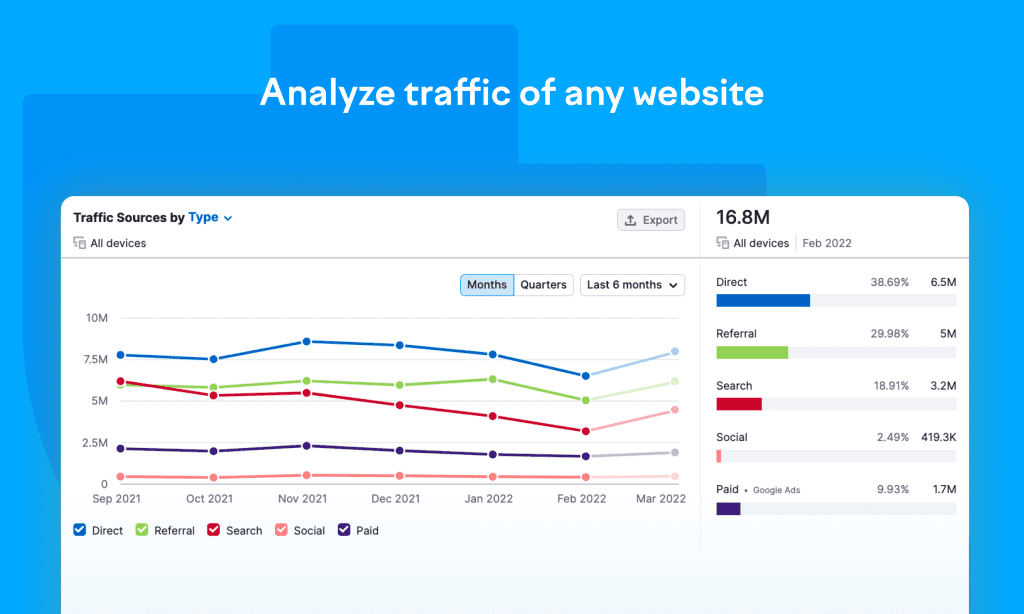
Analyzing Keyword Difficulty and Competition: The Competitive Edge
Semrush’s ability to assess keyword difficulty is a game-changer in crafting an effective SEO strategy.
Let’s explore how this feature provides a competitive edge in the keyword battleground.
Understanding Keyword Difficulty Scores
Keyword difficulty scores provide a quick assessment of the competitiveness of a keyword.
Focusing on low to moderate-difficulty keywords can yield quicker SEO wins.
Competitor Keyword Analysis
Understanding what keywords competitors are targeting unveils strategic insights. The Keyword Gap tool helps identify areas where competitors excel and opportunities to outperform them.
Example: Semrush’s Keyword Gap tool allows users to compare their target keyword with competitors. If “email marketing” is the focus, identifying competitor keywords like “email automation” reveals additional opportunities.
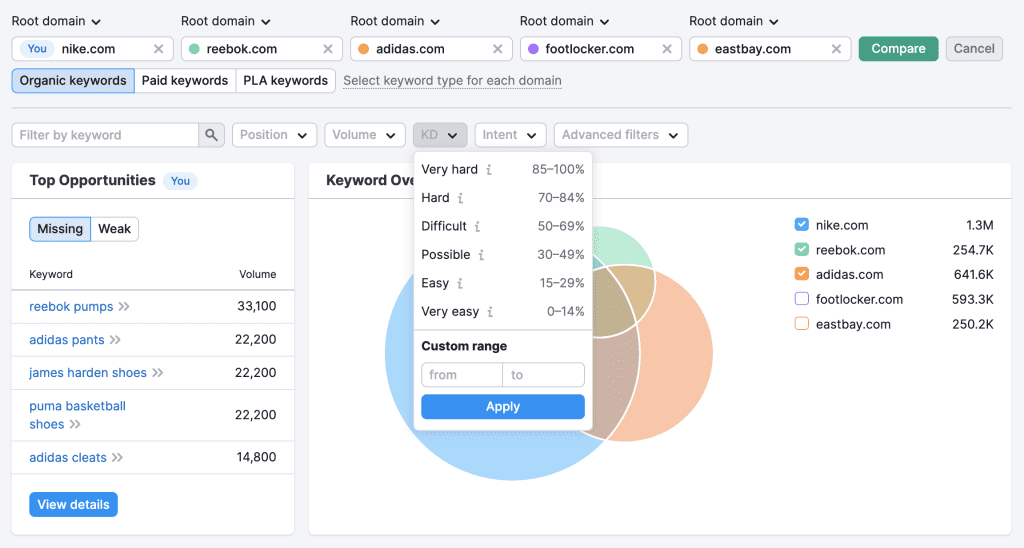
Unleashing the Power of Semrush Keyword Magic Tool: Finding Hidden Treasures
The Keyword Magic Tool within Semrush is a true gem for discovering a vast array of related keywords and uncovering opportunities that might have otherwise remained hidden.
Broad and Narrow Keyword Suggestions
The Keyword Magic Tool provides a spectrum of keyword suggestions, enabling users to refine their focus. From broad to specific, these suggestions empower users to diversify their keyword strategy.
Example: Inputting “digital marketing” into the Keyword Magic Tool generates broad suggestions like “digital marketing” and more specific ones such as “digital marketing companies in singapore.” This comprehensive list aids in expanding keyword targeting.

Filtering and Sorting Capabilities
The ability to filter and sort keywords based on specific criteria streamlines the selection process.
This ensures that users focus on the keywords most aligned with their goals and resources.
Example: Filtering results by search volume or keyword difficulty assists in prioritizing keywords. For instance, if targeting high-volume, low-difficulty keywords aligns with the strategy, the tool allows for efficient sorting.
Leveraging Semrush Position Tracking: Monitoring and Adapting Strategies
Position Tracking in Semrush allows users to monitor keyword rankings over time, providing a dynamic view of SEO performance and informing strategic adjustments.
Tracking Keyword Performance Trends
Continuous tracking of keyword positions unveils trends that can inform strategic decisions. Identifying fluctuations prompts proactive measures to maintain or improve rankings.
Example: Monitoring the position of “SEO strategies” over several months may reveal fluctuations. If there is a sudden drop, it signals a need for investigation into potential algorithmic changes or competitor advancements.
Featured Snippet Opportunities
Gaining insights into featured snippet opportunities is paramount. Position Tracking identifies keywords where featured snippets appear, allowing users to optimize content for this coveted search result feature.
Example: Semrush’s Position Tracking not only monitors rankings but also identifies keywords triggering featured snippets. Recognizing opportunities to secure featured snippets enhances visibility and boosts organic traffic.
5. Advanced Semrush Features for Keyword Research
In the ever-evolving landscape of SEO, mastering advanced tools and features is essential for staying ahead of the curve.
Semrush offers a suite of advanced features that go beyond traditional keyword analysis, providing a deeper understanding of the digital terrain. In this section, we’ll delve into the advanced functionalities that make Semrush a powerhouse for keyword research.

Utilizing the Keyword Gap Tool: Competitive Intelligence Unveiled
The Keyword Gap tool within Semrush allows users to compare keyword profiles with competitors, providing strategic insights into areas of strength and opportunity.
Identifying Competitor Keywords
Recognizing competitor keywords opens doors to untapped opportunities.
Incorporating these keywords into your strategy enhances visibility and ensures a competitive edge.
Example: By comparing your website with competitors, the Keyword Gap tool reveals keywords where competitors have a presence, but your site does not.
For instance, if a competitor ranks for “digital marketing trends,” it becomes an opportunity to optimize content.
Assessing Keyword Overlaps and Unique Opportunities
Understanding keyword overlaps and gaps provides a nuanced view of the competitive landscape. It guides users in choosing keywords where they can outperform competitors.
Example: The tool identifies keywords common to both your site and competitors, showcasing areas of direct competition. Recognizing unique opportunities allows for strategic targeting of keywords that competitors may overlook.
Advanced Insights with Semrush Position Tracking: Beyond Rankings
Position Tracking in Semrush extends beyond basic keyword rankings, offering advanced insights into SERP features and mobile performance.
Monitoring SERP Features
Recognizing SERP features is crucial for a holistic SEO strategy. Users can tailor their content to capture these features, enhancing visibility and attracting a wider audience.
Example: Semrush Position Tracking identifies not only keyword positions but also the appearance of SERP features like featured snippets, knowledge graphs, and local packs. This insight allows for targeted optimization efforts.
Mobile Rank Tracking and Optimization
Understanding mobile rankings is paramount in the mobile-first era. Semrush’s Position Tracking ensures that users optimize content for both desktop and mobile audiences.
Example: Given the surge in mobile searches, Position Tracking provides specific mobile rankings. If “SEO tools” rank higher on desktop but lower on mobile, it signals the need for mobile optimization strategies.
Competitor Analysis with Semrush Organic Research: Unveiling Strategies
Organic Research in Semrush goes beyond keywords, providing a comprehensive view of competitor strategies and enabling users to fine-tune their approach.
Identifying Top Organic Competitors
Knowing top competitors informs strategic decisions. Analyzing their content and keyword strategies guides users in creating content that can outshine competitors in organic search.
Example: By inputting a target keyword, Semrush Organic Research identifies top organic competitors. For “content marketing,” recognizing competitors like HubSpot and Neil Patel reveals industry leaders.
Analyzing Competitor Pages and Backlinks
Understanding the content and backlink strategies of competitors unveils opportunities for improvement.
Users can create more comprehensive content and build high-quality backlinks to enhance authority.
Example: Semrush Organic Research dissects competitor pages and backlinks, revealing high-performing content and link-building strategies. Identifying gaps allows users to refine their content and link-building tactics.
Long-Tail Keyword Discovery with Semrush Keyword Magic Tool
The Semrush Keyword Magic Tool, while previously discussed, deserves a deeper exploration for its prowess in uncovering long-tail keyword opportunities.
Filtering and Sorting Long-Tail Keywords
Filtering and sorting capabilities streamline the process of identifying relevant long-tail keywords. This ensures that users focus on variations aligned with their content and audience.
Example: The Keyword Magic Tool allows users to filter and sort long-tail keywords based on various criteria such as search volume and keyword difficulty. This facilitates focused targeting of specific long-tail variations.
Incorporating Intent-Based Long-Tail Keywords
Long-tail keywords often reflect specific user intents. Incorporating these variations into content aligns with user queries, improving the chances of attracting targeted organic traffic.
Example: Recognizing user intent is crucial in long-tail keyword targeting. If the primary keyword is “best running shoes,” long-tail variations like “best-running shoes for flat feet” cater to specific user needs.
6. Implementing Semrush Keywords into Your Content Strategy
The integration of Semrush keywords into your content strategy is a transformative process that transcends mere optimization—it’s about crafting a narrative that resonates with both your audience and search engines.
In this section, we’ll explore the intricacies of seamlessly weaving Semrush insights into your content strategy for a powerful and strategic online presence.

Incorporating High-Value Semrush Keywords: The Foundation of Content Planning
Choosing the right keywords from Semrush is not just about rankings; it’s about aligning your content with the queries and interests of your target audience.
Targeting Low-Competition, High-Volume Keywords
Choosing keywords with a balance of high search volume and low competition increases the likelihood of ranking well.
This strategic approach maximizes visibility while minimizing competition.
Example: Semrush’s Keyword Overview might reveal “digital marketing trends” as a high-volume, low-competition keyword. Integrating this into your content strategy can attract significant organic traffic.
Long-Tail Keywords for Specificity
Long-tail keywords, often discovered through Semrush, allow you to address niche topics and meet specific user needs.
This granularity enhances the relevance of your content.
Example: The Keyword Magic Tool might suggest long-tail variations like “effective digital marketing strategies for startups.” Incorporating such long-tail keywords caters to a specific audience, enhancing relevance.
On-Page Optimization for Semrush Keywords: Crafting SEO-Enriched Content
Once keywords are identified, the next step is to seamlessly integrate them into your content, optimizing for both search engines and user experience.
Strategic Placement in Titles and Headings
Strategically placing keywords in titles and headings communicates the content’s focus.
This optimization aligns with best practices for on-page SEO, as advocated by Semrush.
Example: Incorporating the primary keyword, like “content marketing strategies,” into the title and headings signals to search engines the central theme of the content. This aligns with Semrush’s recommendations for on-page optimization.
Natural Integration in Content Body
Google’s algorithms prioritize natural language. Integrating keywords organically ensures a positive user experience while signaling relevance to search engines.
Example: Rather than keyword stuffing, seamlessly integrate keywords into the content body. For “social media marketing tips,” crafting a natural sentence like “Explore these effective social media marketing tips” enhances readability and SEO.
Creating a Content Calendar with Semrush Insights: Structuring Your Strategy
A well-organized content calendar, guided by Semrush insights, serves as a roadmap for consistently delivering valuable content aligned with your SEO goals.
Aligning Content with Seasonal Trends
Leveraging Semrush to align content with seasonal trends enhances visibility during peak search periods. A content calendar ensures strategic planning and timely execution.
Example: Semrush’s Trend Analysis may reveal increased searches for “summer fashion trends.” Incorporating this into your content calendar ensures timely and relevant content that aligns with user interests.
Consistent Monitoring and Adjustments
Consistent monitoring using Semrush tools allows for real-time adjustments. A dynamic content calendar ensures that your strategy remains agile and responsive to changing trends.
Example: Semrush’s Position Tracking tool monitors keyword performance. If “email marketing strategies” see a decline in rankings, your content calendar allows for timely adjustments and additional optimizations.
Crafting Semrush-Informed Meta Descriptions: Encouraging Click-Throughs
The meta description, although not a direct ranking factor, plays a crucial role in enticing users to click through to your content.
Crafting Compelling Descriptions with Target Keywords
The meta description is an opportunity to reinforce the relevance of your content. Crafting compelling descriptions with target keywords boosts click-through rates.
Example: For a blog on “SEO best practices,” a meta description like “Unlock the secrets of SEO success with our comprehensive guide on best practices” not only incorporates the target keyword but also entices users to click.
Utilizing Semrush Ad Copy Insights
Semrush’s Advertising Research tool provides insights into effective ad copy. Adapting some of these elements into meta descriptions can make them more compelling.
Example: Semrush’s Advertising Research tool reveals effective ad copy for similar keywords. Incorporating elements of compelling ad copy into meta descriptions enhances their appeal.
7. Monitoring and Adjusting with Semrush
In the dynamic landscape of SEO, monitoring and adjusting are not merely reactive measures; they are proactive strategies for staying ahead of algorithmic shifts, industry trends, and evolving user behaviors.
This section explores how Semrush provides a robust toolkit for continuous monitoring and adjustments, ensuring your SEO strategy remains agile and responsive.
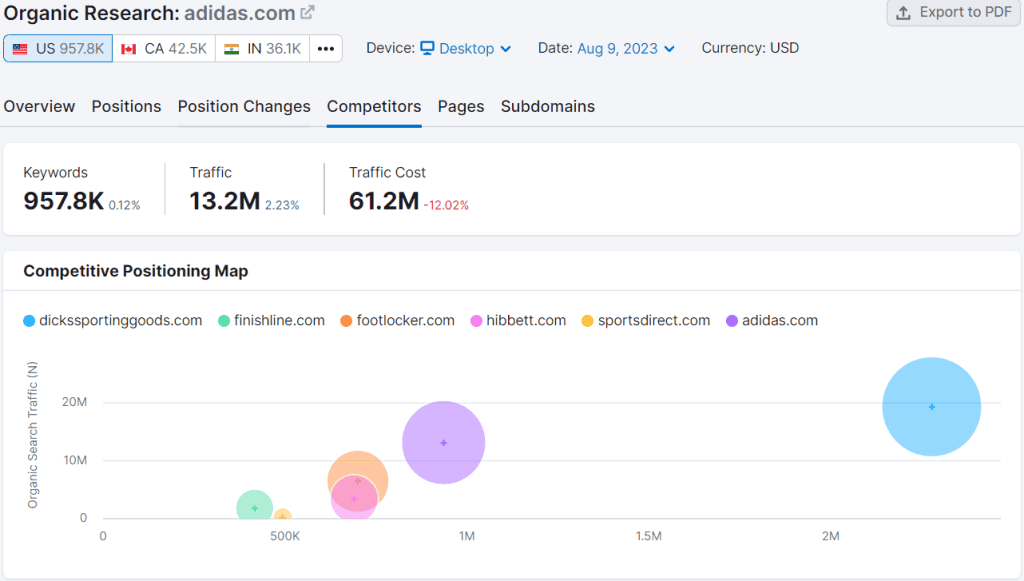
Real-Time Keyword Performance Tracking: The Power of Semrush Position Tracking
Semrush’s Position Tracking tool is your radar in the SEO seas, allowing you to monitor keyword performance in real time and make informed adjustments.
Continuous Monitoring of Keyword Rankings
Real-time monitoring reveals fluctuations in keyword rankings. Detecting declines prompts immediate action to maintain or regain positions.
Example: Utilizing Position Tracking, you observe that your target keyword “digital marketing strategies” has dropped from position 5 to 10. This prompts an investigation into potential changes in search algorithms or competitor strategies.
Competitor Benchmarking and Strategy Refinement
Understanding competitor movements is key. If a competitor outranks you, analyzing their strategy provides insights for refining your approach.
Example: Position Tracking not only monitors your keyword positions but also benchmarks them against competitors. If a competitor gains ground, analyzing their content and backlink strategies informs adjustments to your own strategy.
Analyzing Traffic Trends with Semrush Analytics: Data-Driven Decision-Making
Semrush Analytics provides a comprehensive view of website traffic, enabling data-driven decisions to optimize content and strategies.
Traffic Fluctuations and Algorithmic Impact
Monitoring traffic trends helps attribute changes to specific events. Adjusting strategies based on these insights is crucial for maintaining visibility.
Example: A sudden drop in organic traffic, as highlighted by Semrush Analytics, may coincide with a major algorithm update. Understanding the timing and impact of algorithmic changes guides adjustments to content and SEO tactics.
Refining Content Strategies with Top Pages Insights
Identifying top-performing pages guides content strategy. Replicating success with similar content ensures continued engagement and traffic growth.
Example: Semrush Analytics reveals the top-performing pages on your site. If a blog on “social media trends” consistently attracts traffic, adjusting the content calendar to produce more related content becomes a strategic move.
Backlink Monitoring and Refinement: Enhancing Authority with Semrush Backlink Analytics
Backlink Analytics in Semrush empowers you to monitor backlinks, identify new opportunities, and refine your link-building strategies.
Detecting Changes in Backlink Profile
Monitoring changes in the backlink profile provides insights into the effectiveness of content and outreach efforts. Adjustments can be made based on the quality and relevance of new backlinks.
Example: Semrush Backlink Analytics notifies you of a significant increase in new backlinks. Investigating the source of these backlinks allows you to understand the impact on your site’s authority and make necessary adjustments.
Identifying Lost Backlinks and Recovery Strategies
Loss of authoritative backlinks can impact authority. Semrush enables the identification of lost links, allowing for proactive efforts to recover or replace them.
Example: Semrush alerts you to lost backlinks from an authoritative site. Implementing a recovery strategy, such as reaching out to the site owner or updating content, helps regain valuable link equity.
Social Media Monitoring with Semrush: Adapting to Trends
Semrush extends beyond traditional SEO, offering social media insights that help monitor trends and adjust strategies accordingly.
Tracking Social Media Engagement Metrics
Monitoring social media engagement provides valuable feedback. Adapting content based on trends ensures that your social media presence remains vibrant and relevant.
Example: Semrush Social Media Tracker reveals a decline in engagement for posts related to “digital marketing trends.” Adjusting content strategy based on trending topics ensures continued audience engagement.

Competitor Social Media Analysis for Benchmarking
Understanding competitor social media strategies guides adjustments.
Incorporating successful tactics ensures your social media presence aligns with industry trends.
Example: Semrush enables the analysis of competitors’ social media strategies. If a competitor gains traction with a specific hashtag campaign, adjusting your own social media approach to include trending hashtags becomes strategic.
Conclusion
As we draw the curtains on this comprehensive guide, it’s evident that Semrush Keyword Research is not merely a tool; it’s a compass steering you through the intricate seas of SEO, charting a course to digital excellence.
This journey has unfolded the layers of Semrush, from its foundational features to advanced functionalities, offering a panoramic view of the SEO landscape.
Now, armed with insights and strategies, let’s distil the essence of Semrush Keyword Research into a roadmap for SEO mastery.
Embracing a Holistic Approach to SEO
Semrush transcends conventional keyword research by offering a holistic approach to SEO.
It’s not just about identifying keywords; it’s about unravelling the complexities of search intent, understanding the competitive landscape, and crafting strategies that resonate with both algorithms and human users.
The integration of Semrush into your digital arsenal marks a commitment to excellence—a commitment to optimizing not just for search engines but for the holistic user experience.
Data-Driven Decision-Making: The Semrush Advantage
At the heart of Semrush Keyword Research lies the power of data.
From granular insights into keyword metrics to comprehensive analytics revealing traffic trends and competitor strategies, Semrush empowers you with a wealth of information.
This data-driven approach ensures that every decision in your SEO strategy is grounded in empirical evidence, minimizing guesswork and maximizing impact.
From Keywords to Content: Bridging the Gap
Semrush isn’t just about keywords; it’s about translating keyword insights into compelling content.
The journey from identifying high-value keywords to seamlessly integrating them into your content strategy marks the bridge between visibility and engagement.
As you craft narratives that align with user intent and industry trends, Semrush serves as your guiding light, ensuring your content not only ranks but resonates.
Dynamic Adaptation: The Semrush Advantage
In the ever-evolving landscape of digital marketing, static strategies fall short.
Semrush empowers you with the tools for dynamic adaptation—whether it’s real-time monitoring of keyword positions, adjustments based on algorithmic shifts, or fine-tuning content strategies to align with emerging trends.
The agility to adapt is not just a response to change; it’s a proactive stance toward staying ahead in the digital race.
The Future of SEO Mastery with Semrush
As you embark on your journey armed with the insights from this guide, envision a future where your digital presence is not just optimized but optimized with finesse.
Semrush Keyword Research becomes your companion, guiding you through the nuances of SEO, unravelling opportunities, and propelling your brand to new heights.
In the realm of SEO, mastery is an ongoing pursuit—a journey rather than a destination.
Semrush is not just a tool; it’s your companion on this journey, offering not only features and functionalities but a mindset—a mindset of continuous improvement, adaptability, and strategic excellence.
So, as you set sail into the vast expanse of digital possibilities, may Semrush be your compass, navigating through keywords, algorithms, and user behaviours. May your SEO endeavours be marked by resilience, innovation, and the unwavering pursuit of excellence.
Here’s to your success in the ever-evolving world of SEO, guided by the insights and strategies woven into the fabric of Semrush Keyword Research.
May your digital presence shine brightly, fueled by the mastery you’ve gained through this complete guide. Safe travels on your SEO journey, and may the keywords always align in your favour.
If you are looking for a top-class digital marketer, then book a free consultation slot here.
If you find this article useful, why not share it with your friends and business partners, and also leave a nice comment below?
We, at the AppLabx Research Team, strive to bring the latest and most meaningful data, guides, and statistics to your doorstep.
To get access to top-quality guides, click over to the AppLabx Blog.
People also ask
Is Semrush really worth it?
Yes, Semrush is worth it for anyone serious about digital success. Its robust features empower comprehensive SEO strategies—keyword research, competitor analysis, backlink tracking, and more. The actionable insights it provides are invaluable for optimizing your online presence and staying ahead in the digital landscape.
How to use Semrush for SEO?
To leverage Semrush for SEO, start with keyword research, analyze competitor strategies, and track your site’s performance. Utilize tools like Keyword Magic, Position Tracking, and Site Audit for comprehensive insights. Tailor content based on data to boost rankings and enhance your digital presence.
Is Google Analytics better than Semrush?
Google Analytics and Semrush serve distinct purposes. Google Analytics excels in detailed website analytics, while Semrush is a comprehensive SEO toolkit offering keyword insights, competitor analysis, and more. They complement each other, and using both provides a holistic approach to digital strategy.
































